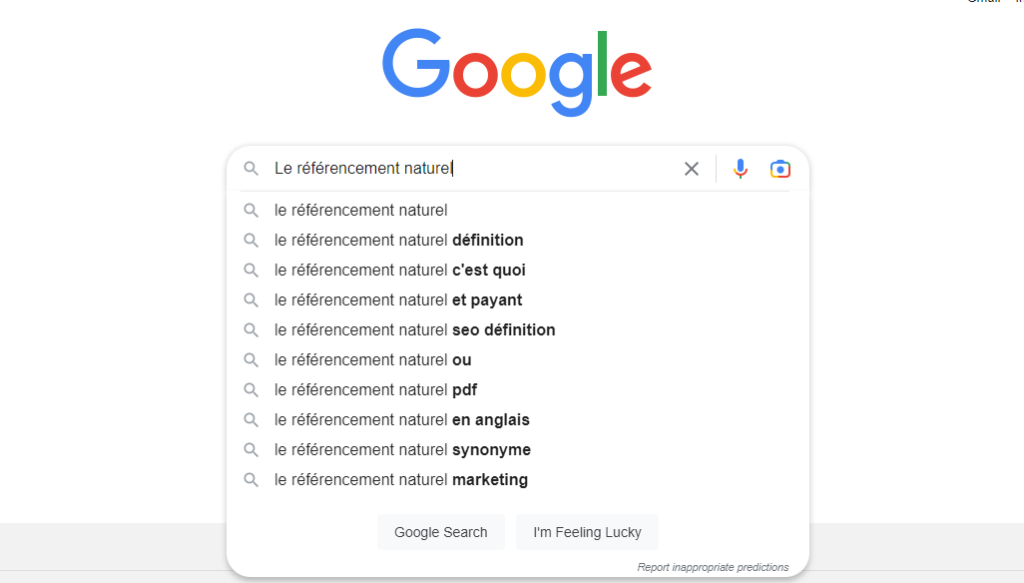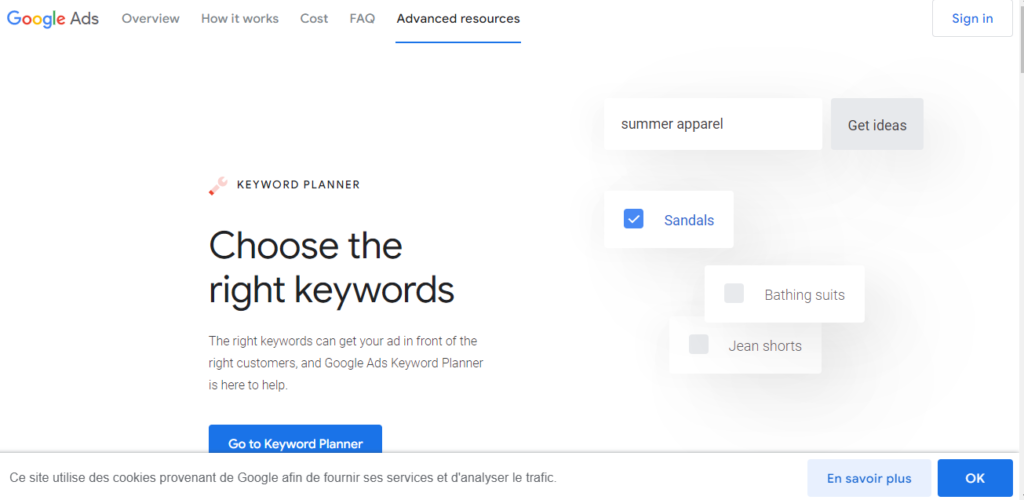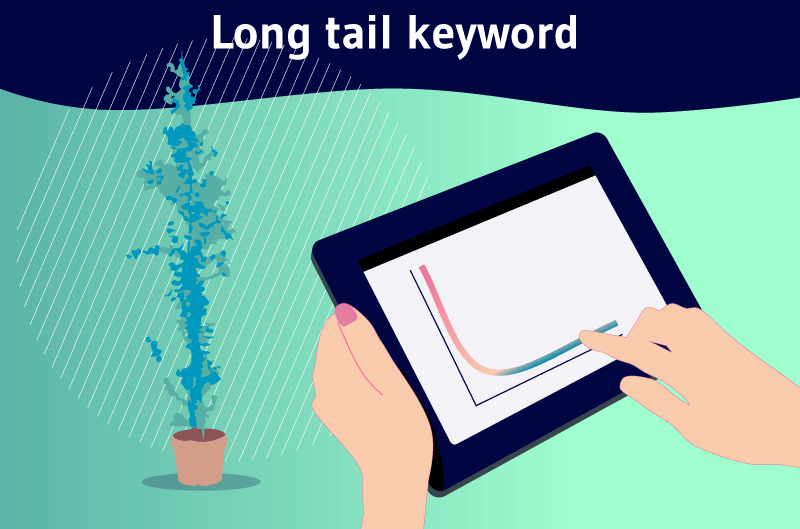Long tail keywords are identified by search terms that contain more words and are technically longer. Because they require more specificity, they tend to get less traffic than shorter search terms.

Did you know that 70% of all internet search traffic is related to long tail keywords?
There is no doubt about it on analytics that show that pages optimized for long tail keywords gain an average of 11 positions compared to 5 positions for main keywords and that their average conversion rate is 2.5 times higher than for main keywords.
Suffice to say, long tail keywords can provide huge benefits to your brand if you know how to implement them.
To give you more ideas on what they really are and how to use them, I invite you to read more of this definition.
Chapter 1: Long tail keywords: What are they?
In this chapter we will discuss what long tail keywords mean and how they are different from short tail keywords.
1.1) What do long tail keywords really mean ?
The term ”long tail” originated in Chris Anderson’s book, The Long Tail, which points out that it is more profitable to sell a wide variety of products in small quantities than to sell only a few items in large quantities

Once this theory was established, the SEO industry adopted it, suggesting that websites could experience more traffic and conversions by focusing on the long tail of the graph.
Longer search terms are often more specific in nature than the main keyword. For example, if your main keyword is ”Pizza,” a long-tail keyword might be ”How to cook pizza” or ”Where to find good pizza.”

Although they are less searched separately, these phrases have certain capabilities to directly reach a wider audience with more chances of conversion.
The metaphor used by experts to describe how long tail keywords work is the Chinese dragon
So, while the head of the dragon is supposed to represent the main keyword, its tail is known to gather the secondary keywords in your content.
While most people focus on searches that generate a lot of volume (the head), others target keywords further down the list (the tail).
1.what are the different types of long tail keywords?
There are two different types of long tail search terms namely
- Supporting long tail keywords
Still called, long tail support keywords, they are those that deal with general topics. While they are technically considered long tail keywords, they are more difficult to rank for, as Google takes specific keywords into account when ranking pages for long tail keywords
This also means that if you are ranking for the general term, you will also be ranking for the supporting long tail phrases.
For example, it can be hard to beat Google’s top results for a low search volume term like ”how to make grilled cheese in a toaster” because that phrase doesn’t represent a specific topic, it’s part of the broader ”grilled cheese” category.
- Thematic keywords with long tail
Long tail thematic keywords focus on a certain product or topic, rather than a general main keyword.
When we search for the term ”private blog network” on Google, we notice that the search result page only displays content about PBNs, this is a sign that we will not have to evoke terms supporting the main term.

In addition to being less competitive, these search terms are characterized by their specificity in terms of search. Thus, they obtain good rankings on the SERPs more easily
Search results for long tail thematic keywords will include pages ranked for the specific term rather than a general topic.
1.3. What is the difference between long tail keywords and short tail keywords?
General terms, also known as main keywords, work best for providing general information. Not surprisingly, when you type terms like “SEO” or “Marketing” into a search engine, it becomes difficult to determine what the person is actually looking for.
In contrast, long tail keywords are long and specific keyword phrases that target users further down the search process. A key characteristic of long tail keywords is that they use descriptive language and longer phrases to be more specific.
To better map out the divergent points between these two types of keywords, we’ve put together a comparison chart for you.
| Long tail keywords | Short keywords | |
| Search volume | Low: Long tail keywords receive less volume than short terms. Nevertheless, this is not a bad signal for businesses. If you have specific products or services that address a specific market, then too much traffic can be detrimental or inconvenient. | High: A shorter keyword will result in more searches than a longer keyword, every time. Thus, your page traffic is identified with the smaller size of your main keyword. If you can get a good ranking for a shorter keyword, your page traffic will be high. |
| Competitiveness | Low: There are fewer competitors when you choose a long tail keyword. When people’s query becomes more specific like “How to make a rat trap”, the results they get will naturally suit them. And if you are selling items, the competition between other sellers is low since few others are selling those specific items. | High: The reason everyone is trying to rank for short keywords is because the volume of traffic is high. However, the competition for these keywords is fierce. For example, if you want to rank for the term “pizza”, you’ll be up against some big local and international pizza brands |
| Focus | High: The targeted search traffic you receive will, for most businesses selling specific items, be very beneficial. It is likely that only people looking for exactly what you offer will enter your store. Therefore, it is a given that you will get customers that fit your target market. | Weak: Searching with short terms is not targeted enough. For example, someone searching for “DVD” might want to buy a player, rent a DVD player, find a DVD movie, locate a DVD playback service. As a result, you may encounter big brand names that you don’t need. |
| Cost | Low: In addition to the benefit of having less traffic, you will also pay much less for low traffic long tail keywords. For example, Google AdWords offers a reduced price if there are more terms in the specific search. So while you may not show up as frequently in general searches initially, it will be much cheaper to get your name out there. | High: If you want to rank for common and short keywords, be prepared to spend a lot of money on Google AdWords. Because the competition for these terms is so high, you will have to pay more than usual for the privilege of appearing in these searches. |
| Conversion rate | High: Another key consideration when selecting long tail keywords is improving conversion rates. If your target audience is typing in specific queries, you will have less difficulty converting website traffic into loyal customers. The degree of success will depend on what you’re selling and other conditions, but metrics show that users who select long-tail keywords generally have better conversions than those who don’t. | Low: The main problem people have with short-tail keywords is the conversion rate. For example, you may get 10,000 searches and 100 clicks for a single term, but only one or two converted customers.While those two customers may be your safest outcome, the truth is that you’d have more luck and less doubt if you use long-tail keywords instead. |
To sum up, long tail keywords are the best option for most businesses, as they offer a good return on investment due to their level of competition which is usually quite low.
In any case, you need to choose what best suits the size and needs of your business to be economical and widely seen on the internet.
Chapter 2: Why use long tail keywords?
When it comes to discussing the benefits that long tail keywords can provide, you can guess a lot of them just from the definition given above.
Nevertheless, here are some of those benefits
2.1. Long tail keywords help low authority pages rank
Fewer websites have authority on the internet, but as their pages have more backlinks, a few industry giants tend to dominate most rankings for high competition keywords. Therefore, if your website is new or doesn’t have enough links to it, you may not get the results you want, even if your content is high quality.
Fortunately, using long tail keywords with more specific search terms can help you in this case

Source: blog.ezoic
The advantage of these keywords for low authority websites is that they have less competition and can easily help these sites rank high even if they don’t have a strong backlink to them.
Nevertheless, for these keywords to be effective, you need to generate relevant content that outranks other pages answering similar queries.
2.2. Long tail keywords are better for voice searches
When optimizing your website for search, it’s important to think about how people actually search. For example, with voice searches, users often use longer queries that are usually directly asked questions

Source: geomarketing
Add to that tools like Siri and Alexa and the conversational element becomes more pressing in this regard.
2.3. Long-tail keywords boost content visibility
In addition to customizing search results for long-tail keywords, Google takes into account variables such as location, age and interests. This means that two users can get different results for the same query
And since long-tail keywords are more specific, however, they can help you optimize your website to attract different types of searchers.
The difficulty with short-tail keywords is that it’s hard to get noticed on search engines like Google, Yahoo, and Bing when there are already so many web pages competing for those general keywords. This competition for organic rankings occurs on the search engine results pages (SERPs) in addition to pay-per-click (PPC) advertising.
Although statistics have confirmed that approximately 70% of search traffic comes from leveraging long tail keywords, this approach is more often overlooked in the on-page optimization process.
By optimizing your content for relevant long-tail keywords, your content will likely be more visible on search result pages. In effect, your brand will appear higher in the SERPs.
Long tail keywords are great for getting your content closer to the most common questions asked by your target audience. This allows you to build an effective customer journey that leads to conversion.
Long tail keywords are able to give your cross-platform content marketing strategy more power by helping people browsing the internet identify you more easily
By using these keywords in quality blog posts and social media posts, you will be able to answer customer questions and solve their problems. Also, using long tail keywords will also help build trust in your brand.
2.4. Long tail keywords have excellent conversion rates
If you’re wondering why you should use long tail keywords, it’s because they can help you reach your target audience with minimal effort.
Long tail keywords are used more often when people know exactly what they want. This way, businesses see more conversions because the user is already interested in that particular topic.
For example, if you search for a professional locksmith by simply typing ”locksmith”, you will get results that include professional as well as amateur locksmiths from almost everywhere. Instead, if you type in “professional locksmith in Paris”, you will get more specific results.


Thus, long-tail keywords can help visitors make a purchasing decision more quickly.
In fact, keywords have a much better conversion rate because of their accuracy in capturing the searcher’s attention
Statistics support this by stating that “the average conversion rate for long tail keywords is 36%”.
When your content is more relevant to what the website visitor wants, you get a higher conversion rate. Businesses that rely on organic search traffic can really benefit from this, as they will get new leads, customers and sales.
2.5. Long tail keywords have a low targeting cost
Not only are long tail keywords great for businesses looking to improve their search engine rankings, but they can also be very beneficial for those running paid search marketing campaigns.
Competition is inevitably lower for long-tail keywords, which means the cost per click of your bid will be lower.
By focusing on longer, more specific keywords for your AdWords promotions, you can get higher ad rankings on related searches without having to spend more for each click.
The challenge is finding a consistent and reliable source of high-quality long-tail keywords that work for you and your niche market.
But the reality is that most keyword generators are only interested in popular keywords, not the lesser known ones.
2.6. Long tail keywords promote the most backlinks
The more traffic your website receives, the more likely you are to get links from other websites.
According to Search Engine People, 33% of clicks on a SERP are attributed to the first result, 15% to the second ranking and 9% to the third result.
For example, if you write 100 blog posts focused on long tail keywords and they start ranking in the top 10, over time you will receive more traffic to your site.
So the higher your page ranks in search engines, the more likely people are to find it and link to it.
2.7. Long tail keywords are also well searched
Contrary to the popular belief of some SEOs, longer search terms are not actually low in search volume. In fact, Ahrefs conducted a study of 1.9 billion keywords and found that about 29.13% of keywords with more than 10,001 monthly searches are three or more words.

So creating a list of high-volume, long-tail keywords can improve your SEO strategy and lead to more conversions.
2.8. Long tail keywords work well for Featured snippets
Featured snippets are a type of search results that appear at the top on SERPs. They are also known as “answer boxes” and provide users with direct answers to their queries
If you optimize your website for long tail keywords, you increase the chances that it will appear in one of these coveted positions.
Since long tail keywords can be created based on queries, these are more likely to be selected for featured snippets
These terms included in content relevant enough to your audience can inevitably improve your ranking in featured snippets.
Ahrefs’ research showed that 8.6% of clicks go to the featured snippet, which means you could also easily get about 8% more search traffic for each long-tail keyword you target if you can access the featured snippet.

Source: marketo
It’s essential to give your website every chance to be successful in SEO.
2.9. Long tail keywords increase your site’s ranking for specific short keywords
Although many SEOs don’t know it, long tail keywords can actually help your main keywords rank faster
Long tail keywords are great for increasing your website traffic, as they allow you to rank for many more specific niche keywords.
The more people visit your site, the more likely they are to come back and Google will start to see your site as an authority on the subject. This allows you to get good rankings for shorter, more competitive terms.
3.10. Long tail keywords help to personalize your content
Short keywords are general and don’t give you any indication of the type of visitor you’ll get to your website
In contrast, long-tail keywords allow you to target specific visitors with content that meets their needs.
Longer search terms help you tailor your content to attract visitors who need what you have to offer
This is a benefit to them, as they get exactly what they are looking for. Likewise, it’s a good thing for your business, because you can write articles that support the different products and services you sell.
Chapter 3: How to get long tail keywords?
There are many ways to find long tail keywords, but in this chapter we will provide you with the best simple tips according to the experts
3.1. Use Google search
By using Google autocomplete or the related search function, you can find longer keywords that are more relevant to what you are looking for
This first method of finding long tail keywords is safer since these terms are provided by Google itself.
All you have to do is enter your main keyword for the Google search to get suggestions for longer terms.

In addition, Google provides a list of semantically related searches at the bottom of the search page.

To find quality keywords related to your business, Google autocomplete and related searches are still the best options available.
3.2. Use Quora
Quora is a great source of information, as the content is generated by the platform’s users themselves. Searching on Quora allows you to find incredibly relevant and unique content that you won’t find anywhere else.
If you want to discover relevant keywords based on long tail questions in your niche, simply enter your main keyword in the Quora search bar.

If you’re having trouble finding relevant content on Quora, try using Google search with the operator ”site: quora.com” and the keyword of your choice.

Quora lists are a valuable tool for writers. Not only do they provide headlines, but the responses can help you understand what searchers are looking for, making your writing process easier overall.
3.3. Consider basic metrics
Evaluating basic metrics is essential to determining a keyword’s usefulness to your website. Thus the verification of the competitiveness of the keyword must also be prioritized and determined from two points namely
- The search volume: It refers to the number of people, on average, who search for a keyword each month;
- Ranking difficulty (KD): This is the difficulty of ranking for a keyword on the SERP, or search engine results page.
If your website is new and doesn’t have much traffic, you should target keywords with a low KD score. A keyword with a high KD score (90+) may be too difficult to rank for, so it’s best to focus on an alternative with a lower score.
Not only do you want your keywords to have a high volume of traffic, but you also want them to be highly relevant. While 20 searches per month may not seem like much, they are actually worth more than 200 searchers bouncing around if the people doing the searches are interested in what you have to offer. This is because the number of searchers that bounce indicates that your content is relevant to them.
3.4. Understand the searcher’s intent
Another important point to consider when it comes to determining the best long tail keywords is search intent
You need to understand what different internet users want to find when they search for the keywords you are targeting.
The purpose of understanding the searcher’s intent is to get a complete picture of who your readers are, what style of content they want, and what topics they want covered in more detail.
To do this, you need to follow a few overarching requirements:
- The first step is to understand what the user wants when they type in a keyword (do they want to buy something, learn more about a topic, etc.) ;
- You need to look at the SERPs to see the type of content that Google thinks best meets the search intent. This could be articles, Q&As, videos, testimonials or reviews;
- You should look for the most popular topics in the search engines by exploring the first few pages of the SERPs while paying close attention to the H2 and H3 titles to get an idea of what people are talking about.
Once you can diagram what your audience wants, you can start by removing from your list of long tail keywords that are not really relevant to your readers.
3.5. Determine the role of each keyword in your content
In addition to your initial main keyword, you now need to identify the long tail keywords that you want to optimize your article for. You can find these keywords by determining whether they are primary or secondary keywords and how well they fit into your planned article.
You can determine where each of your keywords will fit in your content by checking whether it is best suited as a primary or secondary keyword.
Your primary keyword is the most important word on the page, usually a broader, more general topic that your secondary keywords fit into
In contrast, your secondary keyword provides additional detail and specificity to your main keyword. These terms are not self-contained enough, as they would not contain enough information, interest or demand to fill an entire article. It is better to use them as a supporting element for a main keyword.
Chances are you’ve found some great long tail keywords during your keyword research. If they have better search metrics and match the search intent you are looking for, you can replace your current main keyword with one of these new main keywords
Otherwise, if they don’t meet the requirements, you can remove them from your long-tail keyword list and keep them for future content projects.
In any case, it is essential to know how to discern whether a keyword should be primary or secondary. The best way to determine this is to look at your SERP (Search Engine Results Page)
If all the first pages are about a more general topic, it is likely that you have stumbled upon a secondary keyword.
For example, the results page for the query ”What are the materials to make a rat trap”, shows us tips to make a rat trap.

On the other hand, if the SERP for your keyword only shows pages that match your query, you definitely have a primary keyword.

To be successful in your long tail keyword analysis, you should also look at its canonicalization in depth. This occurs when multiple pages in a domain compete for the same key terms, which can commonly hinder your rankings
If you’ve already covered some long tail keywords in other articles, you can remove them from this analysis.
Chapter 4: What are the best long tail keyword research and analysis tools?
4.1. Ubersuggest

This tool is surprisingly a great choice for finding great long tail keywords for your content.
Even with its free version, you can come into possession of vital information about the keywords you get
This information such as the total number of searches per month can help you guide your decisions and make a good sort of longer keywords.
In addition, Ubersuggest returns a variety of other related long-tail keywords based on the one you entered in the initial search.
Ubersuggest helps you choose the right keywords for your Google searches by providing related or similar keywords, as well as content ideas from a list of articles containing the keyword you’re interested in.
4.2. Answer the Public

In addition to helping you identify the best longer keywords for your content, you can also use the Answer the Public tool to analyze the potential of each of these terms. This can be extremely helpful in understanding the questions people are asking about your chosen keyword, as well as related searches.
In addition, the tool uses prepositions and comparisons that can give you even more information about possible keywords.
The free plan will only allow you to perform a few searches, without any data analysis options. If you want to take advantage of the entire tool, you must subscribe to the paid plan.
4.3. LSIGraph

If you’re looking to expand your SEO efforts beyond a single, rigid keyword, consider the LSI strategy instead
LSIGraph is ideal for finding and analyzing semantic long tail terms that are dependent on your primary term.
In just a few seconds, the tool will give you important details about a keyword’s click-through rate and level of competition when you enter a primary term.
Although the free version has some limitations, such as a limit of three searches per day and limited analysis settings, paying for the full version will give you full access to all features without any restrictions.
4.4 Google Keyword Planner

Google’s Keyword Planner, which is now only available to people running a Google Ads campaign, was free for everyone at one point. Its original purpose was to help users create more effective PPC campaigns by giving them insight into certain keywords and the competition.
Content writers often use Google’s keyword planning tool to help them with their research, especially when it comes to long-tail keywords. The tool provides metrics such as search volume data and predictions for the keyword you select.
4.5. Wordtracker

Wordtracker is a great tool for analyzing long tail keywords thanks to its user-friendly interface
To get started, just type your keyword phrase in the search field and press enter. Within seconds, you’ll get a list of long-tail keywords along with the essential information you need to estimate a keyword’s potential.
If you want to get the most out of this tool, you will have to pay for the subscription, because otherwise you will be limited to 50 suggestions and a set number of searches.
Conclusion
In general, long tail keywords are longer terms and characterized by specificity in terms of query intent. Although they are often ignored, long tail keywords have several advantages for any brand that knows how to use them. And to help you with this, we have developed in this article, the best ways to unearth them.



